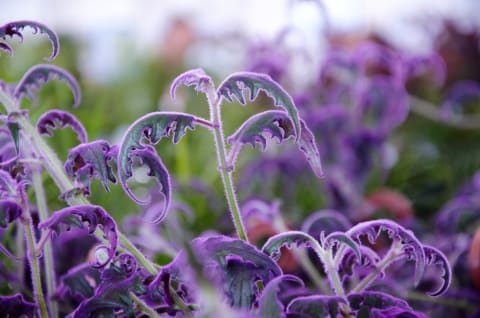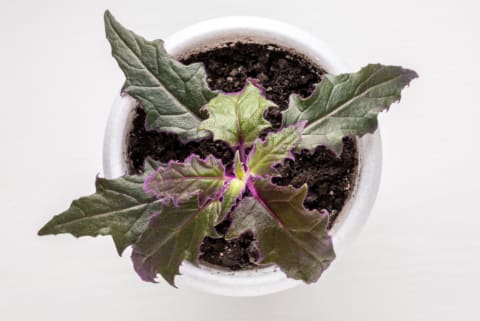Advertisement
How To Keep Your Purple Passion Plant Looking Happy & Bright

Looking for a bit of color to break up your indoor greenery collection? The purple passion plant (Gynura aurantiaca) could be just the thing. This tropical pick boasts fuzzy, electric purple leaves that grow in a unique shape. Intrigued? Here's how to place, water, and tend to the purple passion plant to keep it thriving in your space.
Quick overview:
Gynura aurantiaca, also known as a velvet plant or purple passion plant, is native to Southeast Asia and the global south. It gets its name from the purple, plush growth that naturally forms on its leaves.
Since it thrives in tropical regions, it's no surprise that this is a plant that appreciates sun and moisture. Its soft purple hairs make it a bit more finicky about light and water than other tropical plants, but it's still a relatively low-maintenance plant.

A popular indoor houseplant, you can buy purple passion plants in most garden centers and online plant shops. If you live in a warm region (hardiness zone 10 to 12), you may also be able to keep them as an outdoor plant. Just make sure to give them their own plot or pot, as they can be invasive.
The purple passion plant is a quick grower. Once they get to one to two feet in height, some varieties begin to trail, making them a good pick for a hanging planter.
Unfortunately, this fast growth comes at a cost: This plant has a relatively short life span (two to three years), and once it's ready to go, it blooms very pungent orange-red flowers as a last hurrah.
Fast facts on the Purple Passion Plant
Sunlight needs:
Medium to bright, indirect light
When to water:
Every one to two weeks
Pros:
Unique purple leaves
Cons:
Only lives for a few years and produces bad-smelling flowers before dying back
Where to put it:
In a bright room but away from direct sun
Pet friendly?
Nontoxic to dogs and cats according to the ASPCA
Size:
1-2 feet tall, can be a trailing plant
Sunlight needs.
When deciding where in your home to put your purple passion plant, Kelly Wilkniss, gardening expert and host of My Soulful Home on the Smart Healthy Green Living service, recommends looking for a spot in a bright room that doesn't get much direct sun.
She cautions against sticking them on the windowsill, as too much sunlight can burn their foliage. Signs your plant is getting too much sun include crispy, curling leaves with brown edges.
The tricky thing about this plant is that it isn't happy in conditions that are too dark either. Its purple leaf detail becomes brighter in the sun, so you'll want to make sure it's getting a fair amount of light every day—it just shouldn't be direct.
Sabine H. Schoenberg, the CEO and co-founder of Smart Healthy Green Living, says that it can thrive sitting in the direct morning sun, which tends to be a bit softer than direct afternoon sun, which will burn it.
If you are forced to put your purple passion plant near a window that gets lots of sun later in the day, drawing a sheer curtain can help create ideal conditions for this choosy plant.
Water needs.
Like many tropical plants, this one appreciates drying out between waterings. Always feel its soil before giving it water. It should feel totally dry.
Wilkniss says you'll likely find that you end up needing to water yours about once a week during spring and summer. "Use a watering can with spout or measuring cup to pour the water directly on the soil," she advises. You'll want to avoid getting water on the plant's fuzzy leaves, as Schoenberg says this can cause them to rot and attract pests.

Put your plant in an indoor potting mix in a container that has a drainage hole so you can monitor when water starts coming out. That's your sign the plant has had enough to drink.
If your plant has sad, droopy leaves, it's probably thirsty. If it has a sour, rotting smell or yellow and black leaves, it may have been overwatered and be developing root rot (which you should handle ASAP).
In addition to the weekly watering, your plant will also enjoy a bit of humidity. Place it in a warm, somewhat humid room that mimics the tropical conditions it thrives in. Avoid misting those fuzzy leaves directly, and place the plant near a humidifier instead.
Fertilizer needs.
Fertilize your purple passion plant every two weeks during spring and summer to help fuel its fast growth. You can buy a balanced fertilizer with equal parts nitrogen (N), phosphorus (P), and potassium (K), or try your hand at using a homemade version.
Once your plant really gets growing, it might become too big for its current pot. Keep an eye out for visible roots or an influx of yellow leaves, as these are signs that your plant has outgrown its home and it's time to repot it. (We've got a guide for that.)
How to propagate.
Purple passion plants can be propagated using a stem cutting technique: Simply snip off a few of its leaves at the stem, submerge in water, and allow them to form roots before putting them in a new pot to grow. (We walk through this method in more detail here.)
Feel free to propagate your plant when it's starting to look leggy, with long stems that overpower the leaves, or when it sprouts red-orange flowers. This is a sign that it is preparing to die back, but clipping a few healthy leaves can give it new life again.
Common signs of distress:
- It's leggy: Snip off some of the long stems to give your plant a fuller shape. Be sure to keep the cuttings for propagation!
- Its leaves are green and not purple: This could be a sign that it needs more light. Move it to a brighter spot and see if it helps. As purple passion plants age, they also lose a bit of luster. If your plant is pushing the two-year mark, there may not be much you can do to restore its color.
- It has pests: Purple passion plants are prone to common pests like aphids, mealy bugs, and spider mites. If you see signs of pests—small holes, webbing, or a sticky coating on the leaves—move the plant away from your other greenery and treat it with neem oil right away.
The bottom line.
Purple passion plants make for a fun, unexpected addition to any houseplant collection. Give these tropical stunners proper light and water and they'll reward you with a pop of purple to validate your green thumb.
Watch Next
Enjoy some of our favorite clips from classes
Enjoy some of our favorite clips from classes
What Is Meditation?
Mindfulness/Spirituality | Light Watkins
Box Breathing
Mindfulness/Spirituality | Gwen Dittmar
What Breathwork Can Address
Mindfulness/Spirituality | Gwen Dittmar
The 8 Limbs of Yoga - What is Asana?
Yoga | Caley Alyssa
Two Standing Postures to Open Up Tight Hips
Yoga | Caley Alyssa
How Plants Can Optimize Athletic Performance
Nutrition | Rich Roll
What to Eat Before a Workout
Nutrition | Rich Roll
How Ayurveda Helps Us Navigate Modern Life
Nutrition | Sahara Rose
Messages About Love & Relationships
Love & Relationships | Esther Perel
Love Languages
Love & Relationships | Esther Perel


















